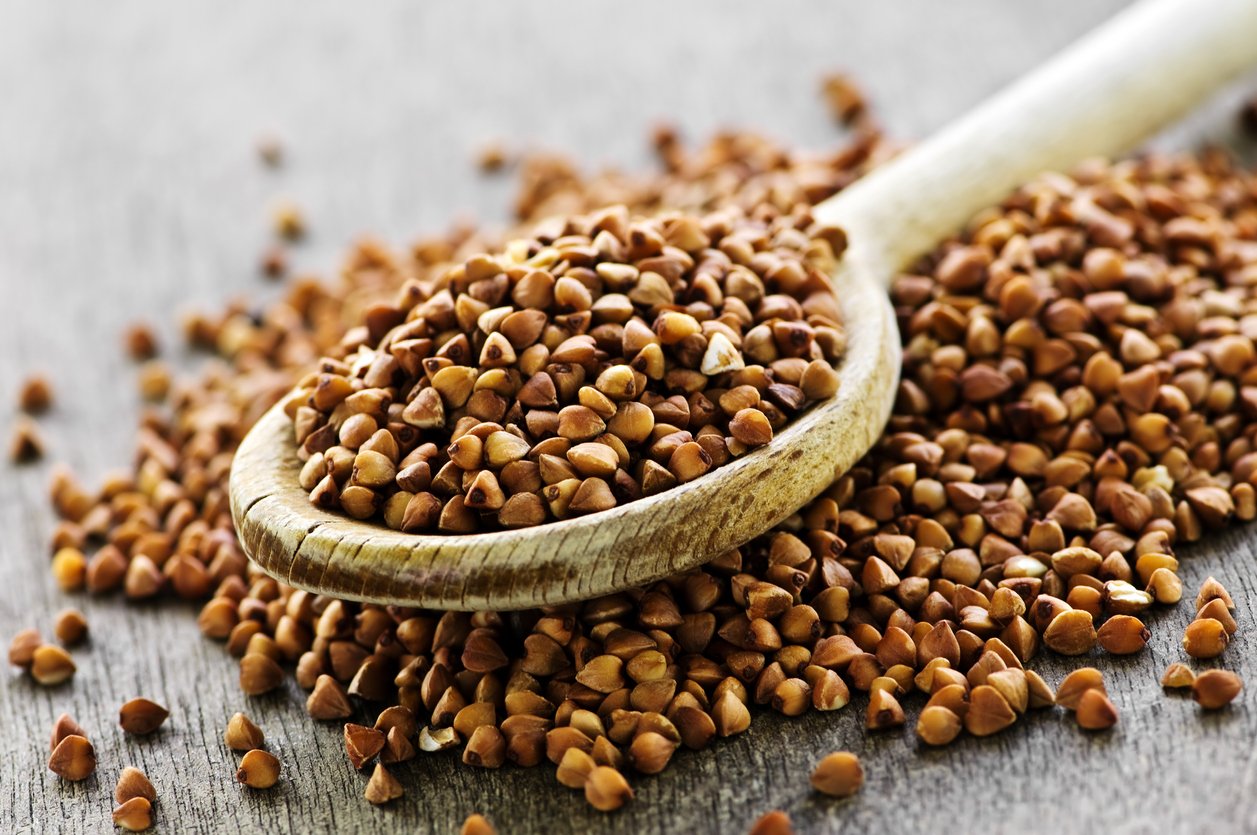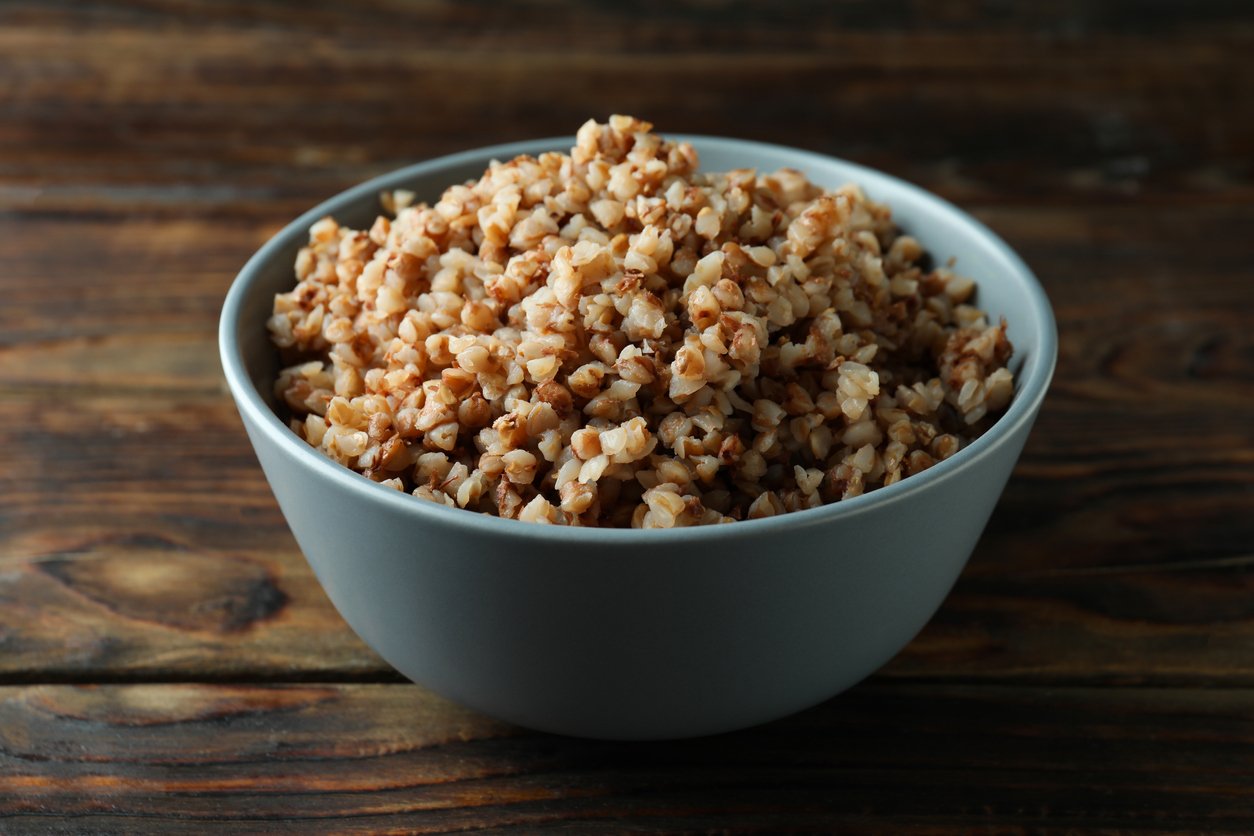by Ocean Robbins: The highest uninterrupted waterfall in the world is Venezuela’s Angel Falls.
We are proud to announce a new partnership with John and Ocean Robbins and the Food Revolution to bring our readers Summits, Seminars and Masterclasses on health, nutrition and Earth-Conscious living.
Your Chance to Attend From Food to Freedom Film for FREE!
The Food Revolution Premiere of From Food to Freedom Film
The world’s tallest tree is named Hyperion, a coastal Redwood growing somewhere in northern California (its exact location is kept secret for its protection). And the domesticated crop that grows at the highest elevation is buckwheat, which was first planted on the Tibetan peninsula around 6,000 years ago.
While gigantic waterfalls and trees can inspire awe, the humble buckwheat plant inspires homier things — pancakes, noodles, and crepes. And despite its name, buckwheat is unrelated to wheat, making it a wonderful comfort food ingredient for those intolerant of or allergic to gluten.
Buckwheat isn’t a major calorie crop like wheat or rice, but it does have a long culinary history in various regions.
In Eastern Europe and Russia, it’s called kasha and appears most famously in a Jewish noodle dish called kasha varnishkes. Buckwheat flour is the backbone of many Asian dishes, too — most notably soba noodles. Buckwheat tea is also popular in China, Japan, and South Korea. And if you’re in North America, you may have heard of, or tried, buckwheat pancakes.
Given how versatile and flavorful it is, and the fact that it can grow in challenging conditions, buckwheat may become more popular than ever before. So I think it’s time we get acquainted with this “pseudocereal” (the word for a plant that isn’t technically a cereal grain, but we use it like one anyway).
In this article, we’ll cover what buckwheat is, if it’s truly appropriate for those avoiding gluten, its health benefits and nutrition, and any downsides worth considering.
What Is Buckwheat?

Buckwheat, or Fagopyrum esculentum, is a flowering plant grown both for human consumption and as a cover crop to suppress weeds and add nutrients to soil.
Buckwheat is a member of the Polygonaceae family, which, despite the name, doesn’t include pentagons and octagons. Instead, it refers to the swollen nodes present on the plants once they’ve seeded — in Greek, “poly” means many, and “gony” means knees or joints. (And esculentum just means “edible,” which is a good thing. I don’t recommend eating any plants deemed “inedible.”)
If you happen to be a gardener in the eastern US, you may be painfully familiar with another member of the Polygonaceae family: knotweed, which is an invasive and difficult-to-remove weed. But aside from botanical closeness, there are no functional similarities. You can safely plant buckwheat in your garden without it taking over.
Buckwheat grows primarily in the northern hemisphere. Botanical historians believe that it originated in China, and from there, cultivars have spread around the world. There are two main types of buckwheat: common buckwheat and Tartary wheat (the latter is eaten more in central Europe and across Asia). Tartary wheat is also used as animal feed.
Is Buckwheat a Grain?
OK, this is where things get confusing. Like amaranth and quinoa, buckwheat is considered a seed or pseudocereal rather than a true grain. Here’s the distinction: The starch granules in pseudocereals are stored in the so-called perisperm (surrounding the seed), unlike cereals, which have them in the endosperm (inside the seed).
If that was confusing, then we need not speak of it again. Let’s just pretend buckwheat is a grain, and cook it and eat it like a grain because we can!
Hulled vs Unhulled Buckwheat

When you buy buckwheat seeds, you’re likely to find hulled ones, meaning they’ve been milled to remove the hard outer shell, known as the hull. That’s because most of the bitter-tasting compounds in buckwheat are in the hull.
The hulled seeds are called groats. You can also get groats from cereal grains like oats, wheat, rye, and barley. Buckwheat groats are also known as kasha, especially when roasted to accentuate their nutty flavor. And in case you’re wondering, hulled buckwheat is considered a “whole grain” by both the USDAand the Whole Grains Council.
If you get your buckwheat seeds hulled, you might be wondering what happens to the hulls. Don’t worry; they’re too valuable to end up in a landfill. They might find their way into a meditation cushion or pillow, or into mulch for gardens.
If you have access to unhulled buckwheat seeds, you can also sprout them into flavorful and amazingly nutritious microgreens. Here’s a video showing the process:
Is Buckwheat Gluten-Free?
Lots of folks assume that anything with “wheat” in its name must contain gluten, which is the primary wheat protein. But as we’ve seen, buckwheat, like its pseudocereal buddies amaranth and quinoa, is a gluten-free grain. That makes buckwheat flour a good alternative for people who have celiac disease or gluten sensitivity.
If it’s imperative that you avoid gluten, you still need to be vigilant when sourcing buckwheat. While buckwheat is inherently gluten-free, it may still undergo processing on equipment that handles wheat. To avoid cross-contamination, look for certified gluten-free varieties.
And some buckwheat products may be mixed with other grain flours, so please read the ingredients and label to verify it’s a truly gluten-free product. For example, soba noodles are often described on the package as “buckwheat noodles,” but the ingredient list may show wheat flour as the first ingredient. That means the buckwheat is there partly for flavoring, as opposed to being the main grain in the product.
Buckwheat Nutrition

Like other grains and pseudocereals, the calories in buckwheat come mostly from carbohydrates. And even hulled buckwheat is a good source of fiber, which is important since fiber is typically lacking in industrialized diets.
We care about fiber because it can act as a prebiotic, feeding your gut’s beneficial bacteria and promoting the formation of short-chain fatty acids (SCFAs). These SCFAs perform a variety of health-promoting tasks, including supporting your gut and immune system, regulating inflammation, and facilitating communication between cells and tissues throughout your body.
Buckwheat is also a source of many minerals including magnesium, manganese, copper, iron, phosphorus, zinc, and selenium, as well as B vitamins. It’s rich in plant sterols and flavonoids, including rutin, which has anti-inflammatory, anticancer, and antioxidant activity, as well as helps to prevent cardiovascular disease. Buckwheat also has higher concentrations of rutin than most other common plant foods (other meaningful sources include unpeeled apples, citrus fruits, asparagus, and figs).
Here’s the nutritional data for one cup of roasted and cooked buckwheat groats (aka kasha):
- 155 calories
- 33.5 grams of carbohydrates
- 5.7 grams of protein
- 4.5 grams of fiber
- 8% Daily Value (DV) for niacin (B3)
- 6% DV for folate
- 21% DV for magnesium
- 34% DV for manganese
- 12% DV for copper
- 12% DV for phosphorus
Is Buckwheat Healthy?
Buckwheat itself checks a lot of “healthy food” boxes. It’s a whole food, and it provides lots of fiber and micronutrients. Even when processed into flour, buckwheat compares favorably to wheat; it has significantly more amino acids, fatty acids, polyphenols, and flavonoids (including rutin) than wheat flour.
Now, any processed grain removes some nutritional benefits, and buckwheat is no exception. Specifically, when compared to an unbroken grain, flour enters your bloodstream faster and could spike your blood glucose levels, which in turn may increase your insulin requirements.
The main issue with buckwheat flour is who it tends to hang out with. Most buckwheat consumption is of flour-based products, including breakfast cereals; bakery products like bread, cakes, and snacks; and noodles. While the buckwheat flour itself will be whole grain, the other flours might very well be refined, with the bran and germ removed.
The healthiest way to eat buckwheat is as a whole, unbroken grain, or in the form of buckwheat sprout microgreens in salads and sandwiches. The sprouts also make a lovely and tasty garnish for soups and stews. Another way to maximize the nutritional goodness of buckwheat is to enjoy teas made from roasted buckwheat grains, leaves, or flowers.
Buckwheat Benefits

With its impressive nutritional profile, you might expect to find lots of evidence that buckwheat improves and protects human health. So let’s see if the evidence supports that assumption.
Buckwheat for Heart Health
You’d think that the nutrients in buckwheat, as well as the fact that it’s a whole grain, would make it a clear winner for the heart. And that’s probably the case, but very few studies conducted so far have had enough statistical strength to make a definitive case. Most of them, as reviewed in a 2018 meta-analysis, looked something like “give 15–30 people some buckwheat crackers for a month and see how they compare to an equal-sized control group.”
While some of these studies do show significant short-term improvement in cardiovascular biomarkers (like cholesterol, blood pressure, and triglycerides), others don’t. In two studies, body weight changed significantly. Unfortunately, the changes were in opposite directions, with one study showing weight gain with added buckwheat. But then again, if you take a bunch of people, and the only change you make to their diet is that you feed them more food (of just about any kind), you may see some weight gain. So that’s hardly definitive.
A 2016 study not included in that meta-analysis provided better news for buckwheat fans. In this one, 165 people with type 2 diabetes were randomized into either a diet that replaced some of their staple foods with Tartary buckwheat or a control diet that left their staple foods alone. The buckwheat group saw significant improvement in both their total and LDL cholesterol after just four weeks.
For lots of reasons, replacing wheat flour (and especially refined white flour) with buckwheat is likely to produce positive effects on cardiovascular health in most people. The reason the human studies didn’t show overwhelming evidence for this is the changes they chronicled were too small to make a difference.
Besides, buckwheat is just one food. The real question is, what is the effect of a minimally processed, plant-based diet on heart health? And we know the answer to that one: pretty darn positive. And replacing white flour with whole-grain buckwheat is one way to move in that direction.
Buckwheat and Diabetes
That 2016 study of 165 people with type 2 diabetes showed, in addition to an improved lipid profile, better insulin resistance when buckwheat replaced foods made from white rice and white wheat flour.
When we generalize to whole grains vs refined flour, there’s lots of evidence that the former is far less likely to lead to a type 2 diabetes diagnosis in the first place. A 2020 meta-analysis of three huge cohort studies (including almost 200,000 people followed for an average of 24 years each) found that those who ate the most whole grains had a 29% lower risk of developing type 2 diabetes than those who ate the fewest. As a whole grain in good standing, buckwheat deserves its rightful place under the whole grain halo.
Is Buckwheat Good for Your Brain?
We know that one of the main mechanisms of neurodegenerative diseases such as Alzheimer’s and Parkinson’s is oxidative stress leading to the creation of reactive oxygen species (ROS) that the affected organs can’t detoxify fast or completely enough.
Rutin, a flavonoid found in buckwheat in high concentrations, has been shown in lab and animal studies to be a powerful antioxidant There’s evidence that rutin can directly scavenge ROS, in effect doing the body’s job for it. Additionally, rutin signals the body’s own immune system to ramp up and remove ROS. Third, it inhibits the production of an enzyme that participates in the metabolism of ROS.
While we don’t have any human trials yet, a 2013 mouse study found that a diet that included Tartary buckwheat improved both cognition and memory in mice whose brains had been (cruelly, in my opinion) injected with amyloid plaque to produce Alzheimer’s-like degeneration.
Buckwheat and Cancer
Rutin appears to disarm cancerous cells as well as ROS. A 2019 study found that flavonoids extracted from Tartary buckwheat inhibited the growth of human gastric cancer cells. Analysis showed that the effect was largely due to the flavonoids’ ability to induce apoptosis (that is, programmed death) in the cancerous cells.
Another compound, this time from buckwheat roots, Lapathoside A, was found in a 2021 study to similarly induce apoptosis in human pancreatic cancer cells. Other studies have shown similar effects on human liver cells.
Is Buckwheat Anti-Inflammatory?
Anti-inflammatory compounds in buckwheat may reduce symptoms of inflammatory bowel diseases. And the effect was significant even when the treatment was relatively mild — the addition of buckwheat flour to white wheat products.
In addition, a 2023 study showed that some of the polysaccharides found in both Tartary and regular buckwheat reduced the symptoms of colitis in rats. Analysis showed that these polysaccharides contributed to the growth of beneficial bacteria populations. The study’s authors suggest that these buckwheat compounds could be potential functional ingredients added to food products. While that could be interesting, I’d suggest that the best way to get these results would be to skip the processed food industry entirely, and just eat more whole buckwheat.
Downsides to Buckwheat

Buckwheat isn’t always a good thing; sometimes it can act as a “little rascal” (I’m not sure how old you have to be to get that reference). Buckwheat allergies are becoming more common in Asia and Europe. And they appear to be true allergies, involving IgE antibodies and causing severe reactions such as anaphylaxis, rather than sensitivities.
Another concern is the agricultural chemical glyphosate, which is used as a desiccant on grains like wheat. Unfortunately, this chemical has been found on buckwheat as well. When possible, you might want to aim for organic buckwheat and buckwheat products to avoid glyphosate and other nonorganic pesticides.
Give Buckwheat a Try!
Buckwheat is a highly nutritious pseudocereal that’s especially useful for celiacs and other people who are sensitive to gluten. With its distinctive nutty taste, it can add pop to your diet, both as an intact grain and as a whole grain flour for pancakes, noodles, and baked goods.
We are proud to announce a new partnership with John and Ocean Robbins and the Food Revolution to bring our readers Summits, Seminars and Masterclasses on health, nutrition and Earth-Conscious living.
Your Chance to Attend From Food to Freedom Film for FREE!






















































